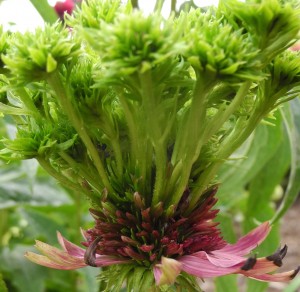Are your purple coneflowers suddenly looking weird — as in truly weird, almost like some alien plant highjacked them and replaced their gorgeous flowering heads with its own? Ah … but it’s really a disease called aster yellows. And those green flower heads? They’re tufts of deformed coneflower leaves erupting amidst the blossoms.

Aster yellows, a microscopic organism known as a type of phytoplasma, has a vector — an enabler. Vectors are insects that could carry a disease; sometimes even dozens of diseases! The disease doesn’t generally infect its vector; it simply uses it as a handy way to hitchhike around. Likewise, on its own that insect vector might not even hurt your plants as it feeds. But if a potential vector has the phytoplasma in its gut, some of that disease may sneak out in its saliva — and into your plants.
With aster yellows, the vector is a tiny leafhopper that migrates northward each summer on storm fronts out of the south. You never know when, where, or if this leafhopper might drop out of the sky and into your garden or nursery bed. Nor could you know which plants might end up becoming phytoplasma food, since aster yellows can hammer about 300 species of garden plants , and weeds .
If it does, then you have exactly one remedy at your disposal: dig up damaged plants and destroy them. Because — aster yellows has no cure. And don’t put off this unwelcome task. The sooner you rouge out infested plants, the better your hope of containing this disease’s spread. And do keep an eye out for foliage that turns yellow while the veins stay green — another telltale symptom of this silent killer.